Functional Dissection of the Physiological Traits Promoting Durum Wheat (Triticum durum Desf.) Tolerance to Drought Stress
Abstract
1. Introduction
2. Results
3. Discussion

4. Materials and Methods
4.1. Plant Material and Experimental Design
4.2. Nondestructive Measurements
4.2.1. SPAD Index
4.2.2. Gas Exchange
4.2.3. Water Potential
4.3. Proline Measurements
4.4. Potassium Analysis in Plant Tissues
4.5. Criteria and Parameters of Analysis
5. Statistical Analysis
Author Contributions
Funding
Data Availability Statement
Conflicts of Interest
References
- Field, R.D.; Kim, D.; LeGrande, A.N.; Worden, J.; Kelley, M.; Schmidt, G.A. Evaluating climate model performance in the tropics with retrievals of water isotopic composition from Aura TES. Geophys. Res. Lett. 2014, 41, 6030–6036. [Google Scholar] [CrossRef]
- Hochholdinger, F. Untapping root system architecture for crop improvement. J. Exp. Bot. 2016, 67, 4431–4433. [Google Scholar] [CrossRef]
- Daryanto, S.; Wang, L.; Jacinthe, P.A. Global synthesis of drought effects on cereal, legume, tuber and root crops production. Agric. Water Manag. 2017, 179, 18–33. [Google Scholar] [CrossRef]
- Mustapha, H.; Ilyas, N.; Akhtar, N.; Raja, N.I.; Zainab, T.; Shah, T.; Ahmad, A.; Ahmad, P. Biosynthesis and characterization of titanium dioxide nanoparticles and its effects along with calcium phosphate on physicochemical attributes of wheat under drought stress. Ecotoxicol. Environ. Saf. 2021, 223, 112519. [Google Scholar] [CrossRef]
- Fleury, D.; Jefferies, S.; Kuchel, H.; Langridge, P. Genetic and genomic tools to improve drought tolerance in wheat. J. Exp. Bot. 2010, 61, 3211–3222. [Google Scholar] [CrossRef]
- Skirycz, A.; Vandenbroucke, K.; Clauw, P.; Maleux, K. Survival and growth of Arabidopsis plants given limited water are not equal. Nat. Biotechnol. 2011, 29, 212–214. [Google Scholar] [CrossRef]
- Wasson, A.P.; Richards, R.A.; Chatrath, R.; Misra, S.C.; Prasad, S.V.S.; Rebetzke, G.I.; Kirkegaard, J.A.; Christopher, J.; Watt, M. Traits and selection strategies to improve root systems and water uptake in water-limited wheat crops. J. Exp. Bot. 2012, 63, 3485–3498. [Google Scholar] [CrossRef]
- Lynch, J.P.; Wojciechowski, T. Opportunities and challenges in the subsoil: Pathways to deeper rooted crops. J. Exp. Bot. 2015, 66, 2199–2210. [Google Scholar] [CrossRef]
- Fang, Y.; Du, Y.; Wang, J.; Wu, A.; Qiao, S.; Xu, B.; Zhang, S.; Siddique, K.; Chen, Y. Moderate drought stress affected root growth and grain yield in old, modern and newly released genotypes of winter wheat. Front. Plant Sci. 2017, 8, 672. [Google Scholar] [CrossRef]
- Kaya, M.; Okçub, D.G.; Ataka, M.; Cikilic, Y.; Kolsaricia, O. Seed treatments to overcome salt and drought stress during germination in sunflower (Helianthus annus L.). Eur. J. Agron. 2016, 24, 291–295. [Google Scholar] [CrossRef]
- Hussain, M.; Malik, M.A.; Farooq, M.; Ashraf, M.; Cheema, M. Improving drought tolerance by exogenous application of glycine betaine and salicylic acid in sunflower. J. Agric. Crop Res. 2008, 194, 193–199. [Google Scholar] [CrossRef]
- Shao, H.B.; Chu, L.Y.; Jaleel, C.A.; Zhao, C.X. Water-deficit stress-induced anatomical changes in higher plants. Comptes Rendus Biol. 2008, 331, 215–225. [Google Scholar] [CrossRef]
- Thapa, S.; Reddy, S.K.; Xue, Q.; Rudd, J.C.; Jessup, K.E.; Devkota, R.N.; Liu, S. Physiological responses to water stress and yield of winter wheat genotypes differing in drought tolerance. J. Agron. Crop Sci. 2018, 204, 347–358. [Google Scholar] [CrossRef]
- Bendarradji, L.; Hadji, N.; Kellou, K.; Benniou, R.; Brini, F. Effet du NaCl et PEG 6000 sur le comportement morpho physiologique et biochimique des variétés de blé dur et tendre. Rev. Agric. 2016, 11, 278–286. [Google Scholar]
- Siddique, M.; Hamid, A.; Islam, M. Drought stress effects on water relations of wheat. Bot. Bull. Acad. Sin. 2000, 41, 35–39. [Google Scholar]
- Inoue, T.; Inanaga, S.; Sugimoto, Y.; El Siddig, K. Contribution of pre-anthesis assimilates and current photosynthesis to grain yield, and their relationships to drought resistance in wheat cultivars grown under different soil moisture. Photosynthetica 2004, 42, 90–104. [Google Scholar] [CrossRef]
- Qaseem, M.; Qureshi, R.; Shaheen, H. Effects of pre-anthesis drought, heat and their combination on the growth, yield and physiology of diverse wheat (Triticum aestivum L.) genotypes varying in sensitivity to heat and drought stress. Sci. Rep. 2019, 9, 6955. [Google Scholar] [CrossRef]
- Monneveux, P.; Rekika, D.; Acevedo, E.; Merah, O. Effect of drought on leaf gas exchange, carbon isotope discrimination, transpiration efficiency and productivity in field grown durum wheat genotypes. Plant Sci. 2006, 170, 867–872. [Google Scholar] [CrossRef]
- Subrahmanyam, D.; Subash, N.; Haris, A.; Sikka, A. Influence of water stress on leaf photosynthetic characteristics in wheat cultivars differing in their susceptibility. Photosynthetica 2006, 44, 125–129. [Google Scholar] [CrossRef]
- Nezhadahmadi, A.; Prodhan, Z.H.; Faruq, G.M. Drought tolerance in wheat. Sci. World J. 2013, 2013, 610721. [Google Scholar] [CrossRef]
- Mwadzingeni, L.; Shimelis, H.; Tesfay, S.; Tsilo, T. Screening of bread wheat genotypes for drought tolerance using phenotypic and proline analyses. Front. Plant Sci. 2016, 7, 1276. [Google Scholar] [CrossRef] [PubMed]
- Ashraf, M.; Foolad, M. Roles of glycine betaine and proline in improving plant abiotic stress resistance. Environ. Exp. Bot. 2005, 59, 206–216. [Google Scholar] [CrossRef]
- Nazarli, H.; Faraji, F. Response of proline, soluble sugars and antioxidant enzymes in wheat (Triticum aestivum L.) to different irrigation regimes in greenhouse condition. Agron. Res. Mold. 2011, 44, 4. [Google Scholar] [CrossRef]
- Ahmad, Z.; Waraich, E.; Akhtar, S.; Anjum, S.; Ahmad, T.; Mahboob, W.; Hafeez, O.B.A.; Tapera, T.; Labuschagne, M.; Rizwan, M. Physiological responses of wheat to drought stress and its mitigation approaches. Acta Physiol. Plant. 2018, 40, 80. [Google Scholar] [CrossRef]
- Maqbool, M.A.; Aslam, M.; Ali, H. Breeding for improved drought tolerance in Chickpea (Cicer arietinum L.). plant. Breed 2017, 136, 300–318. [Google Scholar] [CrossRef]
- Ruszkowski, M.; Nocek, B.; Forlani, G.; Dauter, Z. the structure of Medicago truncatula δ1-pyrroline-5-carboxylate reductase provides new insights into the regulation of proline biosynthesis in plants. Front. Plant Sci. 2015, 6, 869–884. [Google Scholar] [CrossRef]
- Chaieb, G.; Benlaribi, M.; Hazmoune, T. Accumulation d’osmotiques chez le blé dur (Triticum durum desf.) sous stress hydrique. Eur. Sci. J. 2015, 11, 378–395. [Google Scholar]
- Abdalla, M.M. Beneficial effects of diatomite on the growth, the biochemical contents and polymorphic DNA in Lupinus albus plants grown under water stress. Agric. Biol. J. N. Am. 2011, 2, 207–220. [Google Scholar] [CrossRef]
- Kebede, A.; Kang, M.S.; Bekele, E. Advances in mechanisms of drought tolerance in crops, with emphasis on barley. Adv. Agron. 2019, 156, 265–314. [Google Scholar]
- Tränkner, M.; Tavakol, E.; Jákli, B. Functioning of Potassium and magnesium in photosynthesis, photosynthate translocation and photoprotection. Physiol. Plant 2018, 163, 414–431. [Google Scholar] [CrossRef]
- Zörb, C.; Senbayram, M.; Peiter, E. Potassium in agriculture—Status and perspectives. J. Plant Physiol. 2014, 171, 656–669. [Google Scholar] [CrossRef] [PubMed]
- Britto, D.T.; Ebrahimi-Ardebili, S.; Hamam, A.M.; Coskun, D.; Kronzucker, H.J. 42K analysis of sodium-induced potassium efflux in barley: Mechanism and relevance to salt tolerance. New Phytol. 2010, 186, 373–384. [Google Scholar] [CrossRef] [PubMed]
- Tavakol, E.; Jákli, B.; Cakmak, I.; Dittert, K.; Senbayram, M. Optimization of Potassium Supply under Osmotic Stress Mitigates Oxidative Damage in Barley. Plants 2022, 11, 55. [Google Scholar] [CrossRef]
- Verbeke, S.; Padilla-Díaz, C.M.; Haesaert, G.; Steppe, K. Osmotic Adjustment in Wheat (Triticum aestivum L.) during Pre- and Post-anthesis Drought. Front. Plant Sci. 2022, 13, 775652. [Google Scholar] [CrossRef] [PubMed]
- Saha, D.; Choyal, P.; Mishra, U.N.; Dey, P.; Bose, B.; MDe, P.; Gupta, N.K.; Mehta, B.K.; Kumar, P.; Pandey, S.; et al. Drought stress responses and inducing tolerance by seed priming approach in plants. Plant Stress 2022, 4, 100066. [Google Scholar] [CrossRef]
- Chowdhury, M.K.; Hasan, M.A.; Bahadur, M.M.; Islam, M.R.; Hakim, M.A.; Iqbal, M.A.; Javed, T.; Raza, A.; Shabbir, R.; Sorour, S.; et al. Evaluation of Drought Tolerance of Some Wheat (Triticum aestivum L.) Genotypes through Phenology, Growth, and Physiological Indices. Agronomy 2021, 11, 1792. [Google Scholar] [CrossRef]
- Mohammadian, R.; Moghaddam, M.; Rahimian, H.; Sadeghian, S.Y. Effect of Early Season Drought Stress on Growth Characteristics of Sugar Beet Genotypes. Turk. J. Agric. 2005, 29, 357–368. [Google Scholar]
- Bhatt, R.M.; Srinivasa Rao, N.H. Influence of Pod Load Response of Okra to Water Stress. Indian J. Plant Physiol. 2005, 10, 54–59. [Google Scholar]
- Singh, K.B.; Omar, M.; Saxena, M.C.; Johansen, C. Registration of FLIP 87-59C, a drought tolerant chickpea germplasm line. Crop. Sci. 1996, 36, 472. [Google Scholar] [CrossRef]
- Krouma, A. Plant water relations and photosynthetic activity in three Tunisian chickpea (Cicer arietinum L.) genotypes subjected to drought. Turk. J. Agric. For. 2010, 34, 257–264. [Google Scholar] [CrossRef]
- Rosales-Serna, R.; Kohashi-Shibata, J.; AlbertoAcosta-Gallegos, J.; Trejo-López, C.; Ortiz-Cereceres, J.; DKelly, J. Biomass distribution, maturity acceleration and yield in drought-stressed common bean cultivars. Field Crops Res. 2004, 85, 203–211. [Google Scholar] [CrossRef]
- Ping, M.A.; Bai, T.H. Effects of progressive drought on photosynthesis and partitioning of absorbed light in apple trees. J. Integr. Agric. 2015, 14, 681–690. [Google Scholar] [CrossRef]
- Jia, Y.; Xiao, W.; Ye, Y.; Wang, X.; Liu, X.; Wang, G.; Li, G.; Wang, Y. Response of Photosynthetic Performance to Drought Duration and Re-Watering in Maize. Agronomy 2020, 10, 533. [Google Scholar] [CrossRef]
- Blaya-Ros, P.J.; Blanco, V.; Torres-Sánchez, R.; Domingo, R. Drought-Adaptive Mechanisms of Young Sweet Cherry Trees in Response to withholding and Resuming Irrigation Cycles. Agronomy 2021, 11, 1812. [Google Scholar] [CrossRef]
- Arend, M.; Sever, K.; Pflug, E.; Gessler, A.; Schaub, M. Seasonal photosynthetic response of European beech to severe summer drought: Limitation, recovery and post-drought stimulation. Agric. For. Meteorol. 2016, 220, 83–89. [Google Scholar] [CrossRef]
- Gleason, S.M.; Wiggans, D.R.; Bliss, C.A.; Comas, L.H. Coordinated decline in photosynthesis and hydraulic conductance during drought stress in Zea mays. Flora 2017, 227, 1–9. [Google Scholar] [CrossRef]
- Long, S.P.; Baker, N.R.; Raines, C.A. Analyzing the responses of photosynthetic CO2 assimilation to long-term elevation of atmospheric CO2 concentration. Vegetatio 1993, 104, 33–45. [Google Scholar] [CrossRef]
- Lima, A.L.S.; DaMatta, F.M.; Pinheiro, H.A.; Totola, M.R.; Loureiro, M.E. Photochemical responses and oxidative stress in two clones of Coffea canephora under water deficit conditions. Environ. Exp. Bot. 2002, 47, 239–247. [Google Scholar] [CrossRef]
- Pinheiro, C.; Chaves, M.; Ricardo, C. Alterations in carbon and nitrogen metabolism induced by water deficit in the stems and leaves of Lupinus albus L. J. Exp. Bot. 2001, 52, 1063–1070. [Google Scholar] [CrossRef]
- Khakwani, A.A.; Dennett, M.D.; Munir, M.; Abid, M. Growth and yield response of wheat varieties to water stress at booting and anthesis stages of development. Pak. J. Bot. 2012, 44, 879–886. [Google Scholar]
- Hou, P.; Wang, F.; Luo, B.; Li, A.; Wang, C.; Shabala, L.; Chen, L. Antioxidant enzymatic activity and osmotic adjustment as components of the drought tolerance mechanism in Carexduriuscula. Plants 2021, 10, 436. [Google Scholar] [CrossRef] [PubMed]
- Mahmood, T.; Abdullah, M.; Ahmar, S.; Yasir, M.; Iqbal, M.S.; Yasir, M.; Mora-Poblete, F. Incredible role of osmotic adjustment in grain yield sustainability under water scarcity conditions in wheat (Triticumaestivum L.). Plants 2020, 9, 1208. [Google Scholar] [CrossRef] [PubMed]
- Vishwakarma, K.; Upadhyay, N.; Kumar, N.; Yadav, G.; Singh, J.; Mishra, R.K.; Kumar, V.; Verma, R.; Upadhyay, R.G.; Pandey, M. Abscisic Acid Signaling and Abiotic Stress Tolerance in Plants: A Review on Current Knowledge and Future Prospects. Front. Plant Sci. 2017, 8, 161. [Google Scholar] [CrossRef] [PubMed]
- Jákli, B.; Tavakol, E.; Tränkner, M.; Senbayram, M.; Dittert, K. Quantitative limitations to photosynthesis in K deficient sunflower and their implications on water-use efficiency. J. Plant Physiol. 2017, 209, 20–30. [Google Scholar] [CrossRef]
- Jákli, B.; Hauer-Jákli, M.; Böttcher, F.; Meyer zur Müdehorst, J.; Senbayram, M.; Dittert, K. Leaf, canopy and agronomic water-use efficiency of field-grown sugar beet in response to potassium fertilization. J. Agron. Crop Sci. 2018, 204, 99–110. [Google Scholar] [CrossRef]
- Jin, S.H.; Huang, J.Q.; Li, X.Q.; Zheng, B.S.; Wu, J.S.; Wang, Z.J.; Liu, G.H.; Chen, M. Effects of potassium supply on limitations of photosynthesis by mesophyll diffusion conductance in Carya cathayensis. Tree Physiol. 2011, 31, 1142–1151. [Google Scholar] [CrossRef]
- Sánchez, F.J.; Andrés, E.F.; Tenorio, J.L.; Ayerbe, L. Growth of epicotyls, turgor maintenance and osmotic adjustment in pea plants (Pisum sativum L.) subjected to water stress. Field Crops Res. 2004, 86, 81–90. [Google Scholar] [CrossRef]
- Scholander, P.F.; Hammel, H.T.; Bradstreet, E.D.; Hemmingsen, E.A. Sap pressure in vascular plants. Science 1965, 148, 339–346. [Google Scholar] [CrossRef]
- Bates, L.; Waldren, R.P.; Teare, J.D. Rapid determination of free proline for water stress studies. Plant Soil 1973, 39, 205–207. [Google Scholar] [CrossRef]
- Fischer, R.; Maurer, R. Drought Resistance in Spring Wheat Genotypes. I. Grain Yield Responses. Aust. J. Agric. Res. 1978, 29, 897–912. [Google Scholar] [CrossRef]
- Goudarzi, M.; Pakniyat, H. Evaluation of wheat cultivars under salinity stress based on some agronomic and physiological traits. J. Agric. Soc. Sci. 2008, 4, 35–38. [Google Scholar]
- Barrs, H.D.; Weatherley, P.E. A re-examination of the relative turgidity techniques for estimating water deficits in leaves. Aust. J. Biol. Sci. 1962, 15, 413–428. [Google Scholar] [CrossRef]
- Nobel, P. The Boyle-Van’t Hoff relation. J. Theor. Biol. 1969, 23, 375–379. [Google Scholar] [CrossRef] [PubMed]
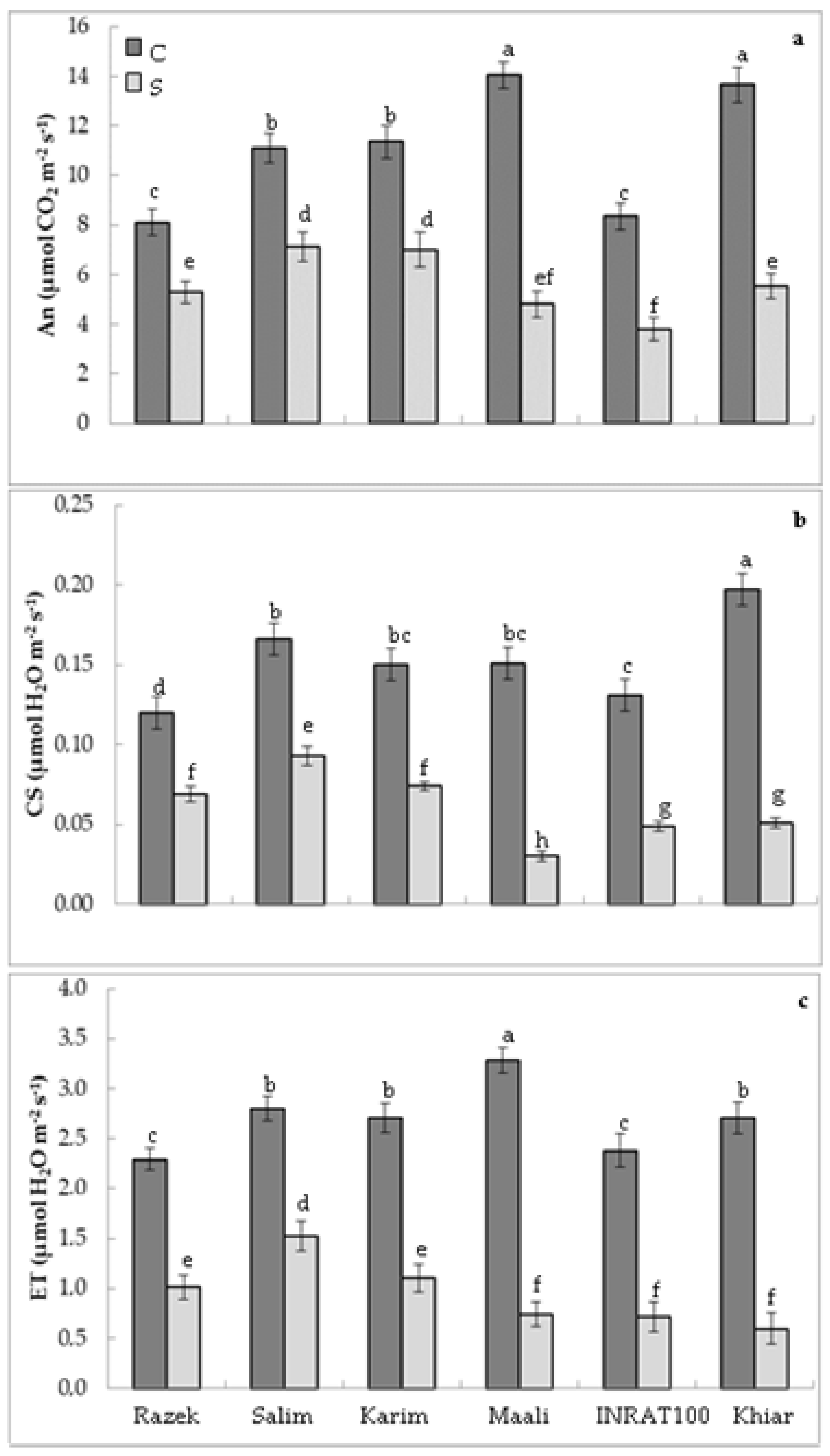
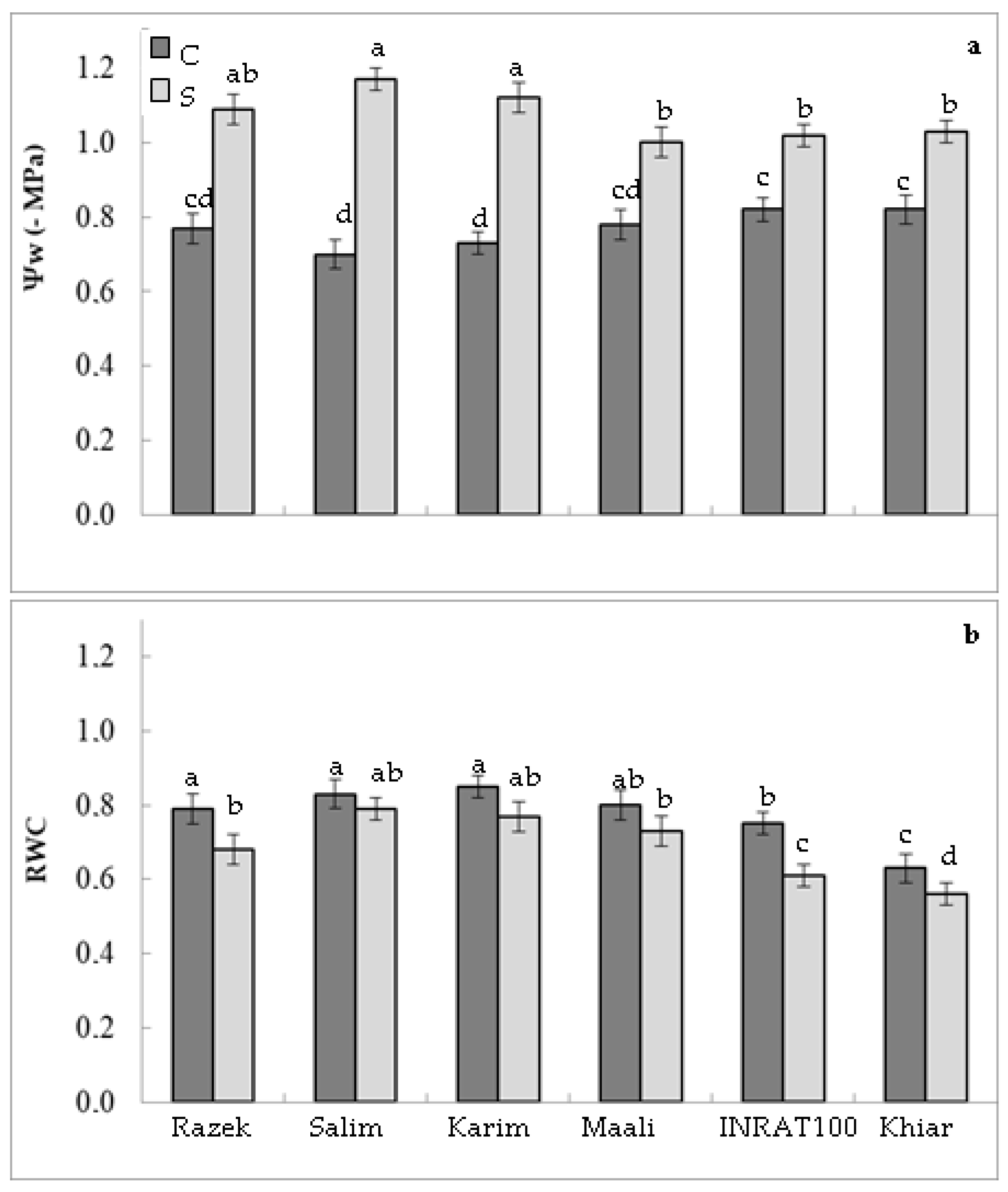


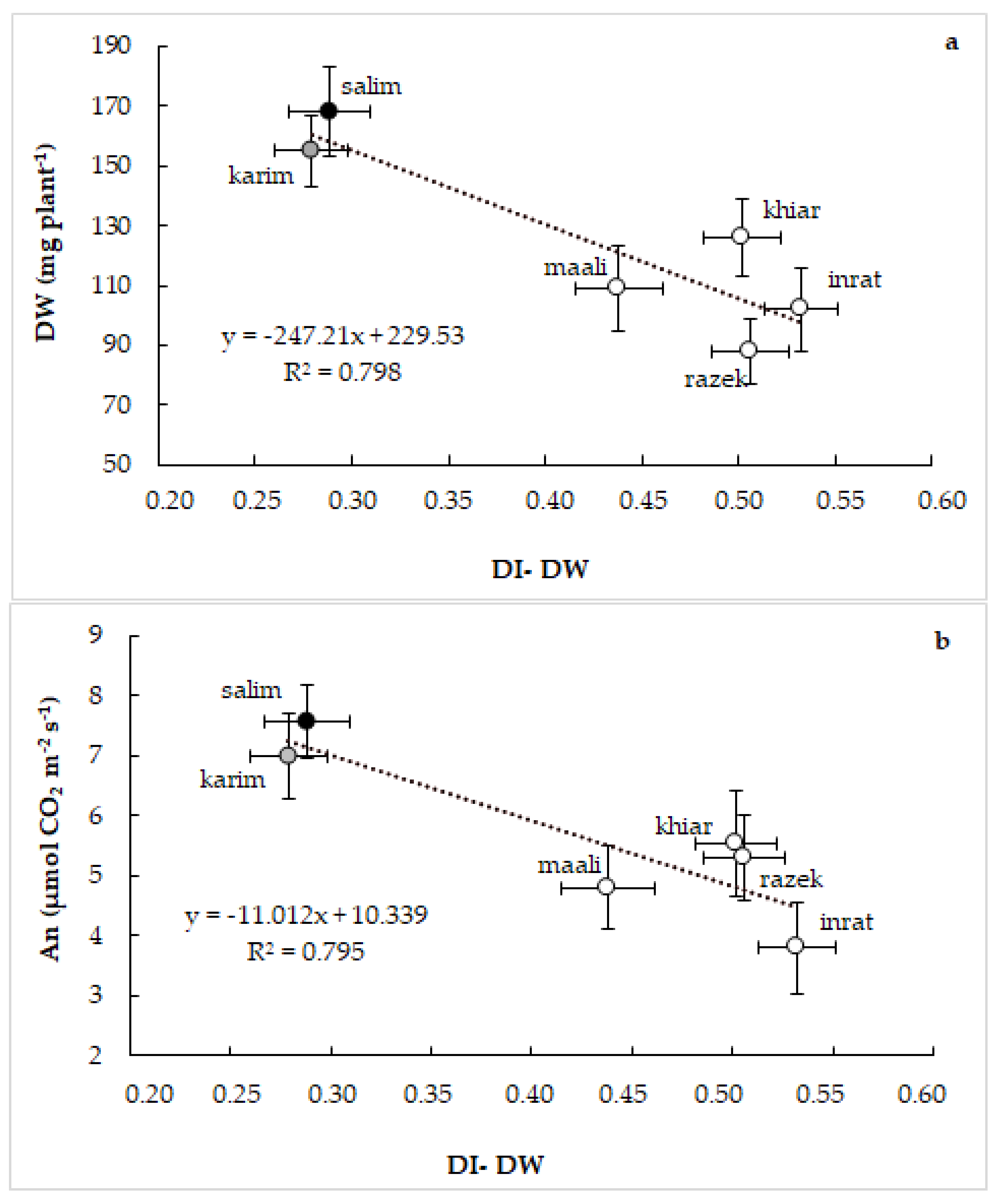
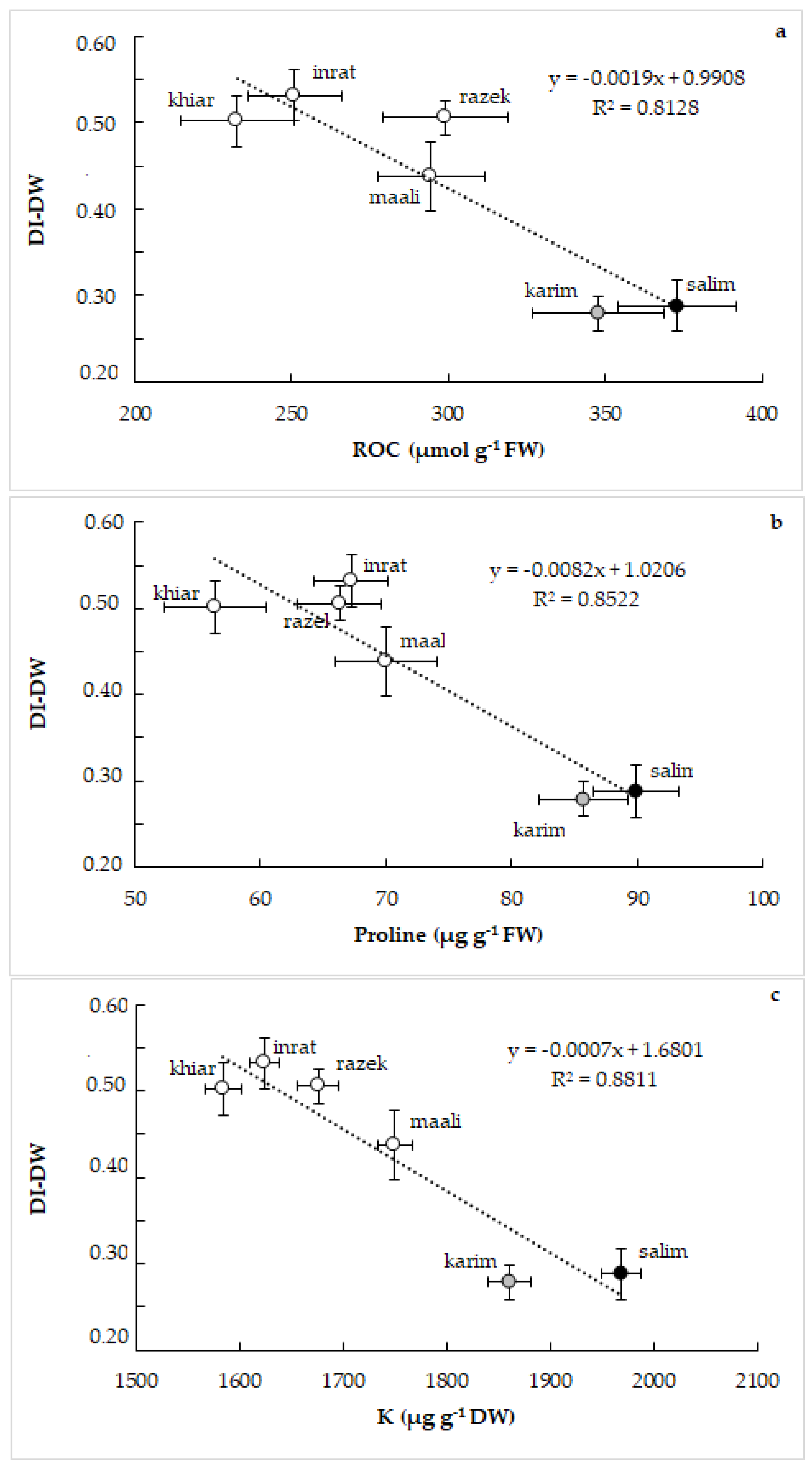
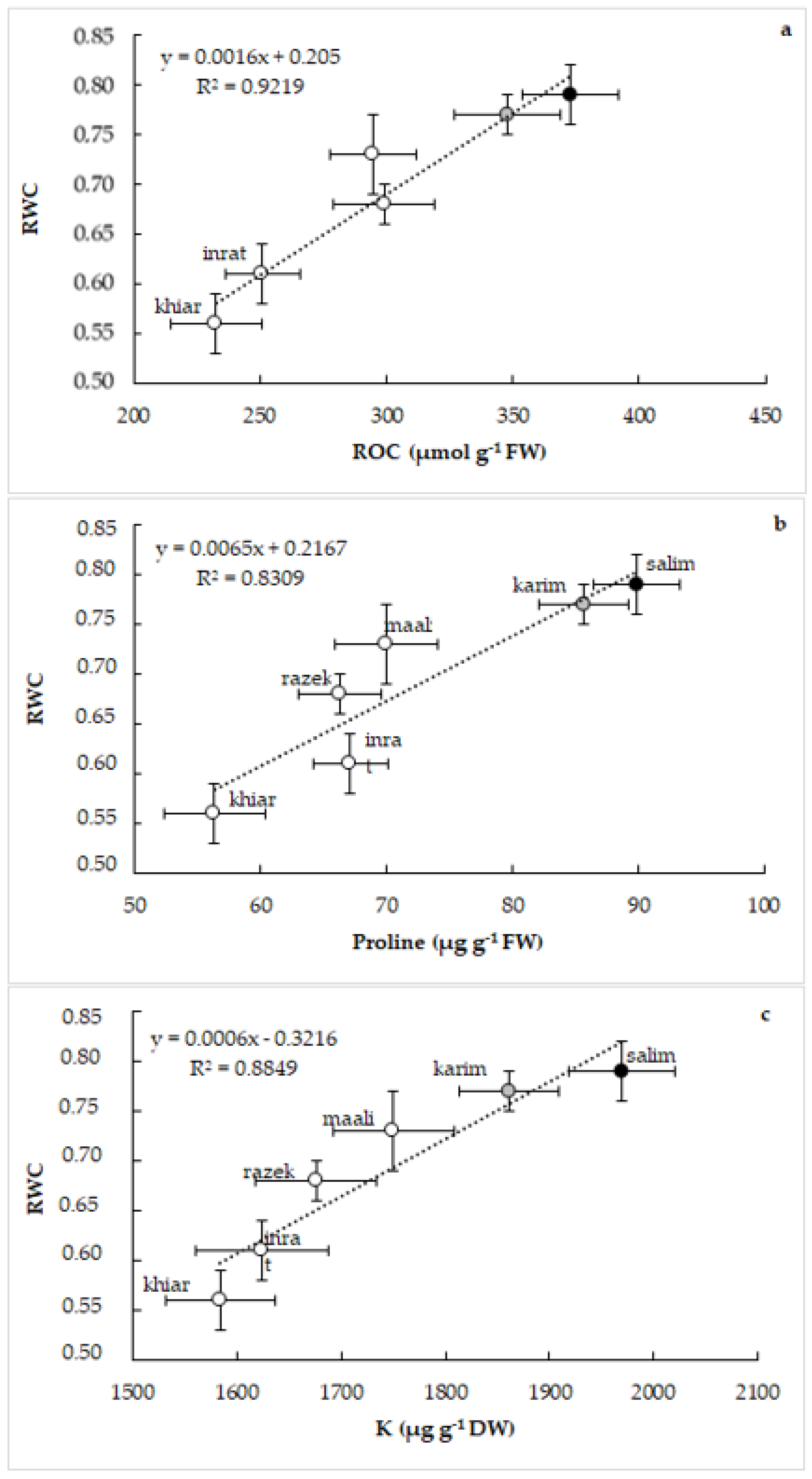
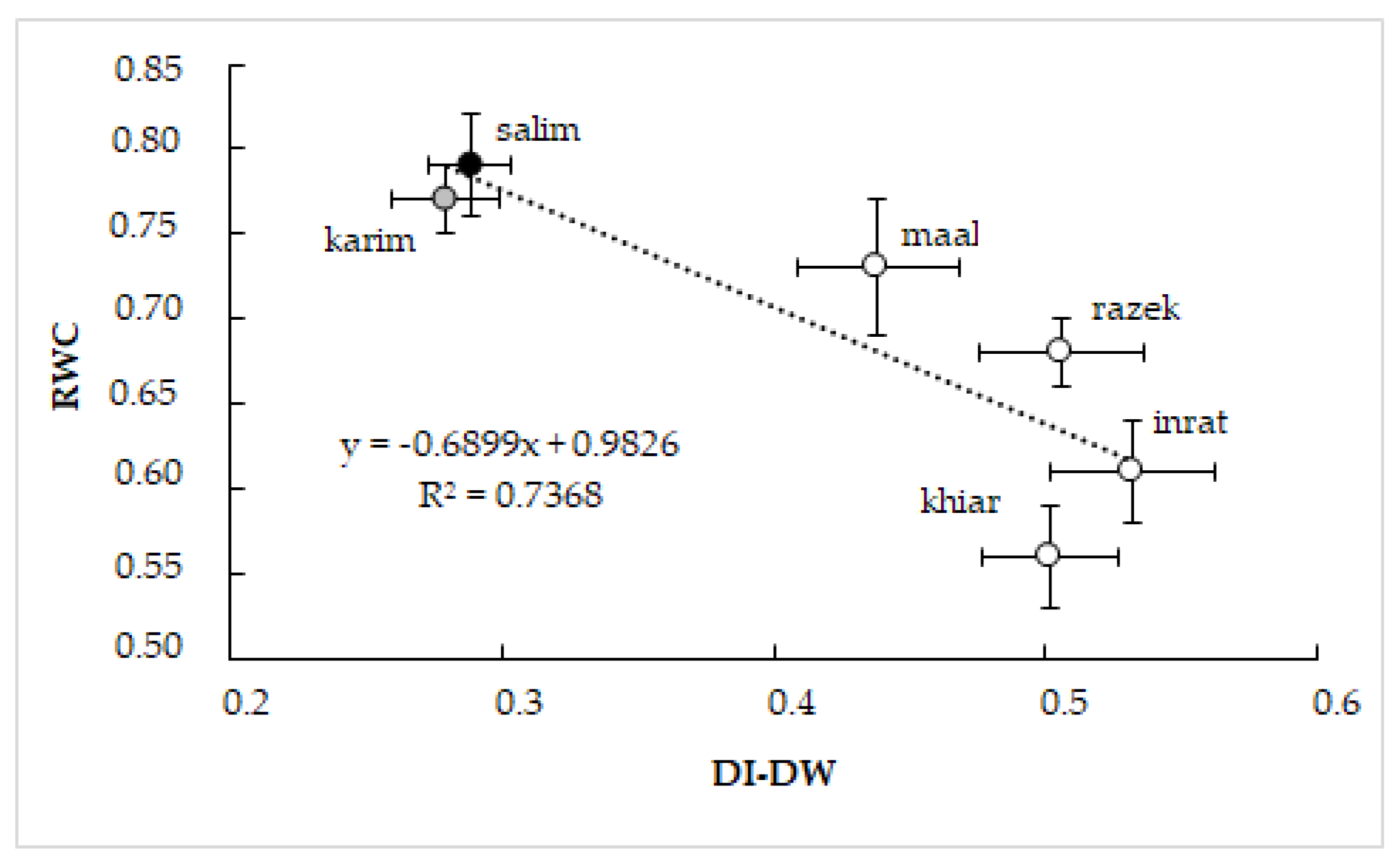
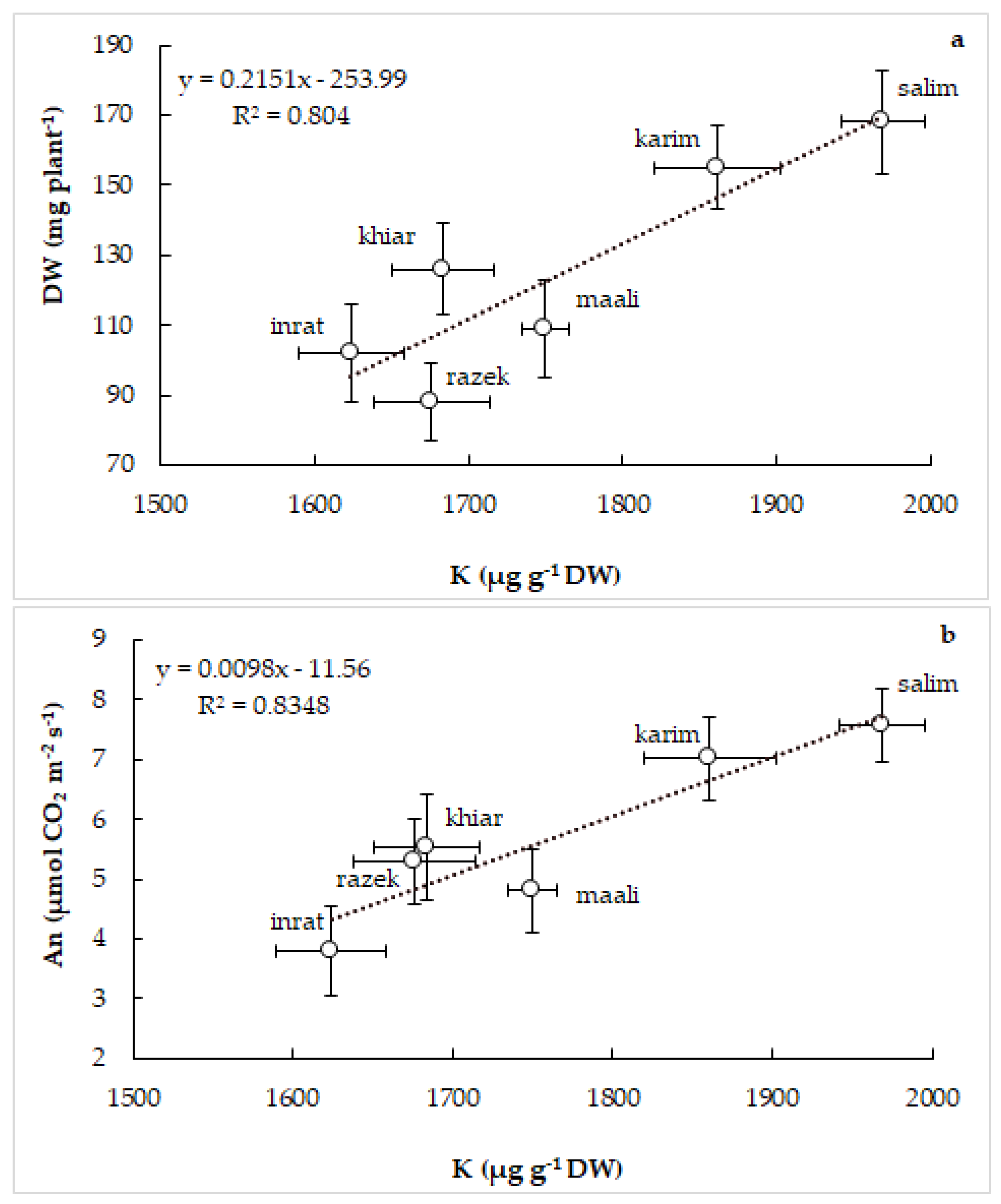
| Spad Index | DW (mg Plant−1) | DI | K Shoots/K Roots | ||||||
|---|---|---|---|---|---|---|---|---|---|
| C | S | C | S | Spad | DW | An | C | S | |
| razek | 30.08 ± 1.8 d | 18.05 ± 1.17 f | 178 ± 15.2 e | 88 k ± 6 | 0.40 ab ± 0.032 | 0.51 b ± 0.038 | 0.35 de ± 0.029 | 1.5 bc ± 0.10 | 1.6 bc ± 0.13 |
| salim | 42.52 ± 1.57 b | 30.52 ± 2.51 d | 236 ± 16.4 b | 168 f ± 15 | 0.28 c ± 0.019 | 0.29 c ± 0.019 | 0.36 d ± 0.031 | 1.5 bc ± 0.11 | 2.0 a ± 0.15 |
| karim | 42.20 ± 2.21 b | 31.28 ± 3.20 d | 215 ± 16.6 c | 155 g ± 12 | 0.26 c ± 0.021 | 0.28 c ± 0.021 | 0.38 d ± 0.028 | 1.3 c ± 0.09 | 1.6 bc ± 0.11 |
| maali | 45.13 ± 1.42 a | 25.27 ± 0.79 e | 194 ± 15.3 d | 109 i ± 14 | 0.44 a ± 0.033 | 0.44 b ± 0.34 | 0.66 a ± 0.042 | 1.7 b ± 0.12 | 1.5 bc ± 0.09 |
| inrat | 39.22 ± 1.40 c | 25.50 ± 1.51 e | 218 ± 17.1 c | 102 j ± 11 | 0.35 b ± 0.027 | 0.53 a ± 0.041 | 0.54 c ± 0.037 | 1.8 ab ± 0.11 | 1.3 c ± 0.08 |
| khiar | 44.73 ± 1.01 a | 26.33 ± 0.71 e | 253 ± 16.2 a | 126 h ± 10 | 0.41 ab ± 0.036 | 0.50 ab ± 0.043 | 0.59 b ± 0.044 | 1.5 bc ± 0.12 | 1.2 c ± 0.08 |
| WUE-DW | WUE-An | KUE-DW | KUE-An | |||||
|---|---|---|---|---|---|---|---|---|
| C | S | C | S | C | S | C | S | |
| razek | 2.17 d ± 0.17 | 1.22 f ± 0.11 | 0.10 b ± 0.011 | 0.07 b ± 0.005 | 100.46 d ± 8.3 | 52.506 h ± 4.2 | 4.58 c ± 0.41 | 3.16 e ± 0.21 |
| salim | 3.06 a ± 0.21 | 2.27 a ± 0.18 | 0.14 ab ± 0.012 | 0.10 a ± 0.010 | 152.74 a ± 10.2 | 85.331 e ± 6.3 | 7.18 a ± 0.43 | 3.84 d ± 0.23 |
| karim | 2.79 b ± 0.18 | 2.18 b ± 0.20 | 0.15 a ± 0.011 | 0.10 a ± 0.010 | 134.88 b ± 11.1 | 83.289 e ± 6.6 | 7.12 a ± 0.52 | 3.77 d ± 0.22 |
| maali | 2.37 c ± 0.19 | 1.70 d ± 0.15 | 0.17 a ± 0.013 | 0.08 ab ± 0.006 | 85.84 e ± 6.7 | 62.286 g ± 5.1 | 6.22 b ± 0.47 | 2.74 f ± 0.19 |
| inrat | 2.63 bc ± 0.20 | 1.55 e ± 0.12 | 0.10 b ± 0.010 | 0.06 bc ± 0.004 | 99.11 d ± 8.5 | 62.808 g ± 5.1 | 3.79 d ± 0.24 | 2.34 g ± 0.17 |
| khiar | 2.98 a ± 0.21 | 1.88 c ± 0.14 | 0.16 a ± 0.012 | 0.08 ab ± 0.006 | 116.98 c ± 9.1 | 74.822 f ± 5.6 | 6.31 b ± 0.46 | 3.29 e ± 0.24 |
| DSI-Spad | DSI-DW | DSI-An | DTI-Spad | DTI-DW | DTI-An | |
|---|---|---|---|---|---|---|
| razek | 1.22 a ± 0.091 | 1.20 b ± 0.11 | 0.83 d ± 0.051 | 0.33 d ± 0.021 | 0.34 d ± 0.025 | 0.60 d ± 0.046 |
| salim | 0.79 d ± 0.052 | 0.68 d ± 0.049 | 0.65 f ± 0.044 | 0.79 a ± 0.046 | 0.85 a ± 0.061 | 1.28 a ± 0.11 |
| karim | 0.73 d ± 0.048 | 0.66 d ± 0.048 | 0.75 e ± 0.047 | 0.80 a ± 0.055 | 0.72 b ± 0.049 | 1.24 a ± 0.093 |
| maali | 1.13 b ± 0.088 | 0.92 c ± 0.087 | 1.35 a ± 0.12 | 0.69 b ± 0.047 | 0.50 c ± 0.031 | 1.03 c ± 0.085 |
| inrat | 0.98 c ± 0.067 | 1.26 a ± 0.099 | 1.29 b ± 0.091 | 0.61 c ± 0.043 | 0.48 c ± 0.033 | 0.60 d ± 0.031 |
| khiar | 1.15 b ± 0.11 | 1.19 b ± 0.077 | 1.21 c ± 0.098 | 0.71 b ± 0.053 | 0.69 b ± 0.047 | 1.15 b ± 0.077 |
Disclaimer/Publisher’s Note: The statements, opinions and data contained in all publications are solely those of the individual author(s) and contributor(s) and not of MDPI and/or the editor(s). MDPI and/or the editor(s) disclaim responsibility for any injury to people or property resulting from any ideas, methods, instructions or products referred to in the content. |
© 2023 by the authors. Licensee MDPI, Basel, Switzerland. This article is an open access article distributed under the terms and conditions of the Creative Commons Attribution (CC BY) license (https://creativecommons.org/licenses/by/4.0/).
Share and Cite
Ltaief, S.; Krouma, A. Functional Dissection of the Physiological Traits Promoting Durum Wheat (Triticum durum Desf.) Tolerance to Drought Stress. Plants 2023, 12, 1420. https://doi.org/10.3390/plants12071420
Ltaief S, Krouma A. Functional Dissection of the Physiological Traits Promoting Durum Wheat (Triticum durum Desf.) Tolerance to Drought Stress. Plants. 2023; 12(7):1420. https://doi.org/10.3390/plants12071420
Chicago/Turabian StyleLtaief, Salim, and Abdelmajid Krouma. 2023. "Functional Dissection of the Physiological Traits Promoting Durum Wheat (Triticum durum Desf.) Tolerance to Drought Stress" Plants 12, no. 7: 1420. https://doi.org/10.3390/plants12071420
APA StyleLtaief, S., & Krouma, A. (2023). Functional Dissection of the Physiological Traits Promoting Durum Wheat (Triticum durum Desf.) Tolerance to Drought Stress. Plants, 12(7), 1420. https://doi.org/10.3390/plants12071420







